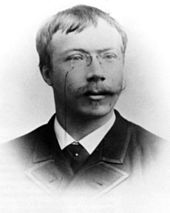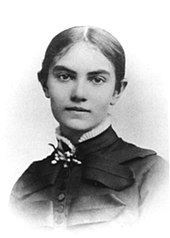Carl Larsson
Carl Olof Larsson (born May 28, 1853 in Stockholm , † January 22, 1919 in Falun ) was a Swedish artist .
His paintings , watercolors and drawings mostly show the life of his family (together with his wife Karin Larsson had eight children) in and around the house in Sundborn , Sweden. Carl and Karin are considered to be the founders of today's “typically Swedish” style of living, the essential elements of which are brightness, color and lively, cheerful functionality. The house is now a museum. Larsson became famous in Germany from 1909 onwards for his book Das Haus in der Sonne .
He is counted as part of the Arts and Crafts Movement .
life and work
Carl Larsson grew up in poor circumstances. When he was 13 years old, his teacher encouraged him to study at the Royal Academy of Arts in Stockholm. To pay for his studies, he was forced to work on the side. For example, he worked as a retoucher for a photographer. After he was awarded a royal medal in 1876, he was financially a little better.
In 1877 Larsson was able to make his first trip to Paris . His third trip to France in 1882 took him to the artists' colony Grez-sur-Loing near Fontainebleau , where he made numerous watercolors of the surrounding nature. Here he also met Karin Bergöö , who soon became his wife. The couple returned to Sweden for the wedding. “This was a turning point in Larsson's life. In Grez, Larsson painted some of the most important of his works, but now in water colors, and very different from the oil paint technique he used before, ”says the book Carl and Karin Larsson - Your Life and, edited by Michael Snodin and Elisabeth Stavenow-Hidemark their art… .
Between 1885 and 1888 Larsson mainly painted views of Stockholm. He joined the artist group Opponenterna , which called for a reform of art education at the art academy. However, these claims were rejected. In 1886 Larsson was also head of an art school in Gothenburg .
In 1888 the family received a small house near Sundborn from Larsson's in-laws. The house was gradually expanded, decorated and expanded by Carl and Karin, both technically and artistically, and became known under the name "Lilla Hyttnäs" (roughly: small hut). The house became Larsson's artistic focus, the couple's seven children (an eighth died shortly after their birth) were raised here and, together with the village community, immortalized in numerous oil paintings and watercolors typical of Larsson. The house has been preserved true to the original as a family museum and still serves as a meeting place for the family.
After another stay in Paris, where the triptych Rokoko-Renässans-Nutida Konst was created, he was commissioned by the National Museum in Stockholm to design the interior walls of this building. From 1896 he painted six walls al fresco , including the pictures Gustav Wasas Entry into Stockholm on Midsummer Eve 1523 and Gustav Adolf's Landing in Germany . In 1896 he received a small gold medal at the International Art Exhibition in Berlin .
Midvinterblot (midwinter victim), 1915
Kräftfångst ( Crayfish Catch ), 1895
Portrait of August Strindberg , 1899
Portrait of Selma Lagerlöf , 1908
Brita as Iduna
Other works by Carl Larsson can be found in Stockholm in the Royal Opera and in the Royal Dramatic Theater (Dramaten) and in Gothenburg in the Hvitfeldtska Gymnasium. Another image ( midvinter blot ) was rejected during Larsson's lifetime; still very angry, he finished the work. It was not until 1997, after numerous detours, that it came to the place in the National Museum intended by Larsson.
Home and Family became famous in the 1899 album Ett hem (Home). The collection Das Haus in der Sonne from 1909 increased its popularity in Germany. Larsson's memoir, entitled Jag (Ich), which he completed shortly before his death in 1919, was not published until 1931.
Already during Larsson's lifetime there were some extremely successful exhibitions and competition entries in Germany, including in Berlin and Munich. The largest exhibition to date in Germany took place at the turn of the year 2005/2006 in the art gallery of the Hypo-Kulturstiftung in Munich.
Exhibitions
- 2005/06: Carl Larsson - A Swedish Fairy Tale . Exhibition in the art gallery of the Hypo-Kulturstiftung , Munich
- 2014: Carl Larsson - L'Imagier de la Suède . Petit Palais , Musée des Beaux-Arts de la Ville de Paris, Paris
Publications
- De Mina . Stockholm 1895 (Bonnier), German after d. 2nd edition 1919 as Die Meinen, Königstein i. Ts. 1978 (Langewiesche Nf.), ISBN 3-7845-2725-6
- Ett hem . Stockholm 1899 (Bonnier), German as our home, Königstein i. Ts. 1977/1996 (Langewiesche Nf.), ISBN 3-7845-2130-4
- Larssons . Stockholm 1902 (Bonnier), German as The Larssons . Koenigstein i. Ts. 1978/2006 (Langewiesche Nf.), ISBN 978-3-7845-2731-4
- Spadarvfet, with lilla landtbruk . Stockholm 1906 (Bonnier), German as Bei uns auf dem Lande, Berlin 1907 (Bruno Cassirer), new edition Königstein i. Ts. 1977/1996 (Langewiesche Nf.), ISBN 3-7845-2745-0
- The house in the sun . Düsseldorf and Leipzig 1909, The Blue Books (Karl Robert Langewiesche), revised edition, Königstein i. Ts. 2015 (Langewiesche Nf.), ISBN 978-3-7845-2701-7
- At solsidan . Stockholm 1910 (Bonnier), German as Let light in, Stockholm and Leipzig 1911 (Bonnier); new edition as on the sunny side, Königstein i. Ts. 1977/2005 (Langewiesche Nf.), ISBN 3-7845-2736-1
- Andras barn . Stockholm 1913 (Bonnier), German as Anderer Menschen Kinder, Berlin 1913 (Bruno Cassirer), new edition Königstein i. Ts. 1978/2006 (Langewiesche Nf.), ISBN 978-3-7845-2721-5
- Jag . Stockholm 1931 (Bonnier), German as Ich, Carl Larsson - A book about good and bad, Königstein i. Ts. 1985/2006 (Langewiesche Nf.), ISBN 978-3-7845-2738-3
literature
- Johann Georg Prince of Hohenzollern (Ed.): Carl Larsson. A Swedish fairy tale (exhibition catalog). Munich 2005. ISBN 3-7774-2765-9
- Hans-Curt Köster (Ed.): Carl Larssons Welt . Koenigstein i. Ts. 2003 ISBN 3-7845-2708-6
- Lena Rydin: The pleasure of everyday life. Live like the Larssons in Sundborn . Koenigstein i. Ts. 2003, ISBN 3-7845-2723-X
- Catalog raisonné: Ulwa Neergard: Carl Larsson. Signerat with brush and penna . Two volumes, Norstedts, 1999 (Swedish). ISBN 91-1-300704-1
- Michael Snodin, Elisabet Stavenow-Hidemark (eds.): Carl and Karin Larsson - Your life and your art (exhibition catalog, London and Stockholm 1997/98, German). Weingarten 1998. ISBN 3-7845-2733-7
- Renate Puvogel : Carl Larsson - watercolors and drawings . Taschen Verlag, Cologne 1993, ISBN 3-8228-8420-0
- Cecilia Lengefeld: The painter of the happy home. To Carl Larsson's reception in Wilhelmine Germany . Winter, Heidelberg 1993, ISBN 3-8253-0105-2 .
- Karl-Erik Granath and Ulf Hård af Segerstad (eds.): The Carl Larsson-Hof (Carl Larsson's sun house) . Photos by K.-E. Granath, text by U. Hård af Segerstad, Vlg. Langewiesche, Königstein / Ts. 1975, ISBN 3-7845-7280-4
- Velhagen & Klasings monthly booklets, XXVII vol. 1, 1912/1913, Franz Servaes: Carl Larsson, pp. 105–118, with partly colored illus.
Individual evidence
- ^ Carl Olof Larsson . national museum. Retrieved March 1, 2019.
- ↑ The memoirs have also been published in German translation: Carl Larsson: Ich . Langewiesche publishing house, Königstein im Taunus, 4th edition 2006
Web links
- Literature by and about Carl Larsson in the catalog of the German National Library
- Works by and about Carl Larsson in the German Digital Library
- Works by Carl Larsson at Zeno.org .
- The Carl and Karin Larsson Family Association (Swedish, English)
| personal data | |
|---|---|
| SURNAME | Larsson, Carl |
| ALTERNATIVE NAMES | Larsson, Carl Olof |
| BRIEF DESCRIPTION | Swedish painter |
| DATE OF BIRTH | May 28, 1853 |
| PLACE OF BIRTH | Stockholm |
| DATE OF DEATH | January 22, 1919 |
| Place of death | Falun |

















